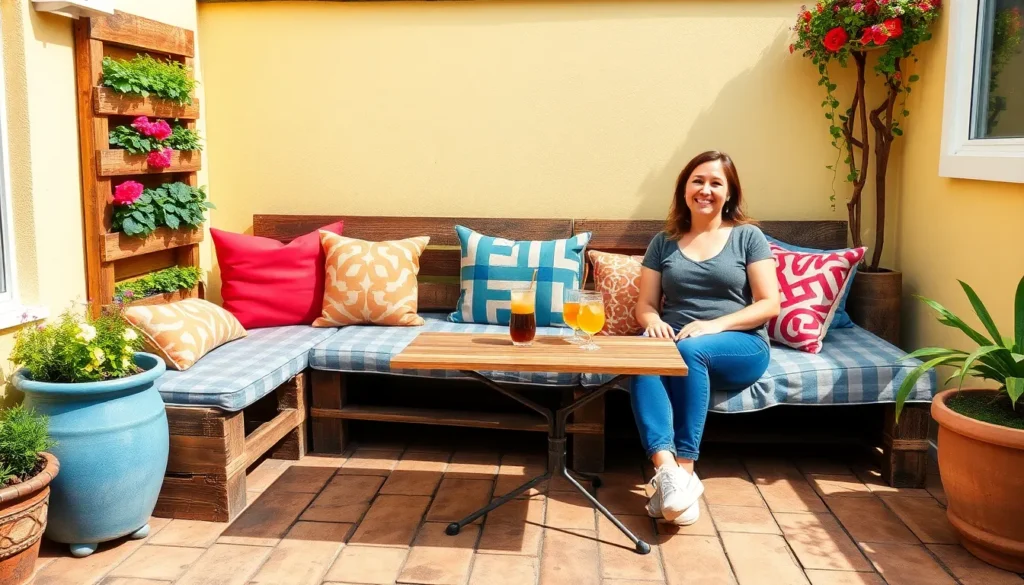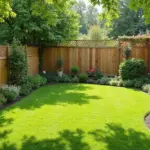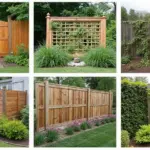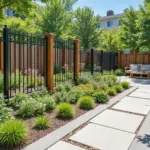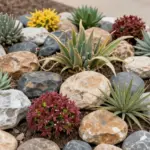We’ve all seen those wooden pallets stacked behind stores and warehouses but what if we told you they’re actually hidden gems for transforming your garden and patio? These versatile structures can become stunning planters, cozy seating areas, and creative storage answers that’ll make your outdoor space the envy of every neighbor.
Pallet gardening isn’t just a trend—it’s a smart solution for budget-conscious homeowners who want maximum impact without very costly. Whether you’re working with a sprawling backyard or a tiny balcony we’ll show you how these simple wooden frames can revolutionize your outdoor living experience.
From vertical gardens that maximize growing space to rustic furniture that adds instant charm we’re about to unlock the endless possibilities hiding in plain sight. Get ready to transform those overlooked pallets into the outdoor oasis you’ve always dreamed of creating.
Transform Your Garden With DIY Pallet Planters and Raised Beds
Pallets become powerful gardening tools when we repurpose them into planters and raised beds. These structures maximize growing space while keeping costs minimal.
Vertical Pallet Garden Walls for Small Spaces
Vertical pallet gardens solve space constraints by growing upward instead of outward. We can attach industry fabric to the back of a standard pallet and fill the slats with potting soil to create instant planting pockets.
Installation requires securing the pallet to a fence or wall using heavy-duty screws and brackets. The structure should lean slightly backward at a 10-15 degree angle to prevent soil from falling out and ensure proper water retention.
Plant selection works best with shallow-rooted varieties like lettuce, herbs, strawberries, and succulents. These crops thrive in the limited soil depth that pallet slats provide, typically 4-6 inches deep.
Watering systems can include drip irrigation or soaker hoses threaded through the top slats. This method ensures even moisture distribution throughout all planting levels without oversaturating lower pockets.
Tiered Pallet Planter Boxes for Herbs and Vegetables
Tiered designs create multiple growing levels using stacked pallet sections cut to different lengths. We typically use three tiers measuring 48 inches, 36 inches, and 24 inches to form a pyramid shape that maximizes sun exposure for all plants.
Construction involves cutting pallets lengthwise and reassembling them into rectangular boxes. Each tier needs a plywood or cardboard bottom liner to contain soil, with drainage holes drilled every 6 inches to prevent waterlogging.
Growing zones allow us to plant different crops based on their needs and harvest times. The top tier works well for quick-growing herbs like basil and cilantro, while middle and bottom levels accommodate larger vegetables such as tomatoes and peppers.
Mobility features can be added by attaching casters to the bottom tier. This modification lets us move the entire planter system to follow sunlight patterns or protect plants during harsh weather conditions.
Pallet Raised Garden Beds for Easy Maintenance
Raised bed construction uses whole pallets as the foundation walls, creating beds that measure 40×48 inches on average. We secure corners with metal brackets or wooden corner posts to ensure structural stability throughout growing seasons.
Height benefits reduce bending and kneeling during planting, weeding, and harvesting activities. Standard pallet beds stand 5-6 inches high, but we can stack multiple pallets to reach 10-12 inches for deeper root vegetables like carrots and potatoes.
Soil quality improves dramatically in raised pallet beds because we control the growing medium completely. A mixture of 40% compost, 30% topsoil, and 30% peat moss or coconut coir provides optimal drainage and nutrition for most garden plants.
Season extension becomes possible with removable covers made from clear plastic sheeting or row cover fabric. These additions protect crops from frost and extend growing seasons by 4-6 weeks in both spring and fall.
Create Comfortable Outdoor Seating Areas Using Recycled Pallets
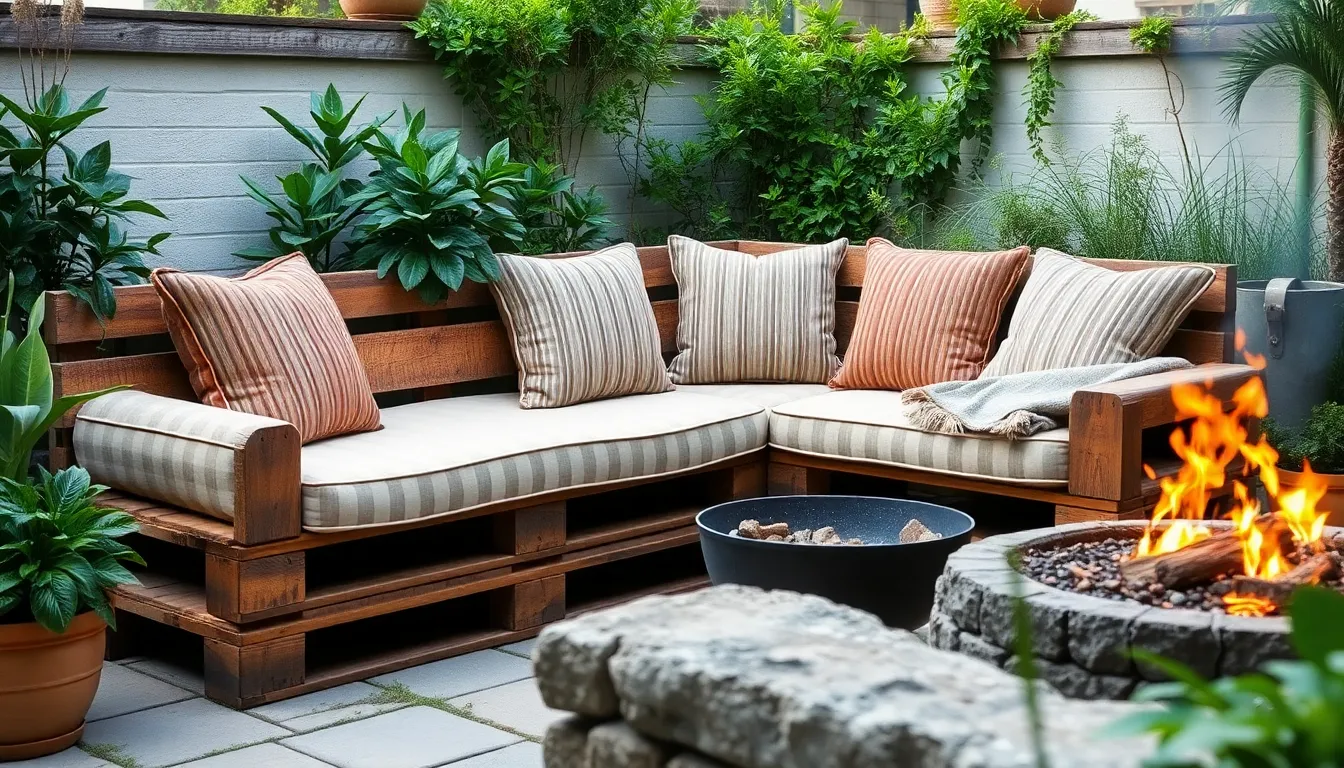
Transforming recycled pallets into comfortable outdoor seating combines sustainability with style while creating functional spaces for relaxation. We’ll explore how these versatile wooden structures can become the foundation for various seating answers that enhance your patio and garden areas.
Pallet Sofa and Lounge Chair Designs
Stack pallets horizontally to create the base structure for sofas and lounge chairs that provide ample seating space. Sand the wood surface smooth to eliminate splinters and rough edges that could damage cushions or clothing. Paint or seal your pallet furniture with outdoor-resistant finishes to protect against weather damage and extend its lifespan.
Cut pallets to desired dimensions to fit your exact patio layout and space requirements. Add thick outdoor cushions and weather-resistant fabric covers to transform the rustic wooden base into comfortable seating. Secure multiple pallets together using bolts and screws to create longer sofa configurations that accommodate more guests.
Position your pallet seating strategically around fire pits or outdoor dining areas to create cohesive conversation spaces. Choose neutral paint colors like gray or white to complement existing outdoor decor themes.
Pallet Swing and Hammock Installations
Create pallet swings using one or two pallets as the primary seating structure for a relaxing outdoor experience. Cut one pallet to form both the seat and backrest assembly, ensuring proper proportions for comfortable use. Strengthen the backrest by adding wooden blocks and side supports to enhance stability and safety.
Attach durable nylon ropes to the corners of your pallet seat assembly for secure hanging installation. Use gym hooks and heavy-duty straps specifically designed for swing applications to ensure safe weight distribution. Hang your pallet swing from sturdy overhead supports such as strong tree branches or custom-built frames.
Apply outdoor paint and add weather-resistant cushions to improve both aesthetics and comfort levels. Sand all surfaces thoroughly before assembly to create a smooth finish that won’t snag clothing or skin.
Pallet Bench Seating for Garden Pathways
Transform pallets into simple benches that provide convenient rest stops along garden walkways and paths. These sturdy seats maintain an organic, rustic appearance that complements natural garden environments. Position benches at strategic intervals to create comfortable viewing points for enjoying your industry.
Enhance pallet benches with outdoor cushions in colors that coordinate with your garden’s seasonal plantings. Apply painted finishes that match your overall garden theme, whether that’s bright colors for cottage gardens or natural stains for woodland settings. Secure benches to the ground in high-traffic areas to prevent movement and ensure stability.
Place benches near focal points such as water features, flower beds, or scenic overlooks to maximize their functional value. Consider adding back supports by attaching additional pallet sections vertically for extended comfort during longer sitting periods.
Design Functional Storage Solutions for Your Patio Space
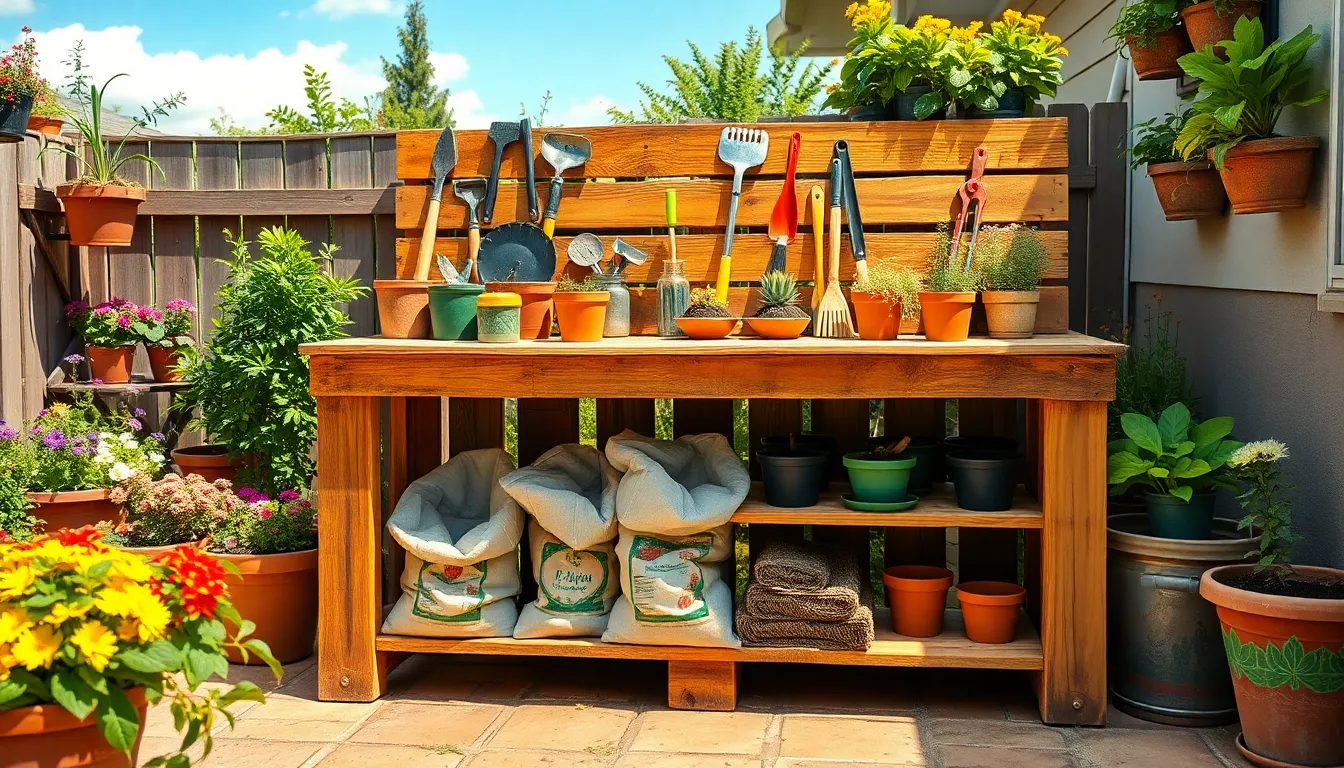
Moving beyond seating and planting projects, we’ll explore how pallets can transform your outdoor storage capabilities. These versatile answers keep your garden organized while maintaining the rustic charm we love about pallet projects.
Pallet Tool Storage Racks and Organizers
Vertical tool storage becomes effortless when we mount pallets against walls or fence posts. The natural slatted design creates perfect slots for hanging rakes, shovels, pruning shears, and hand tools, keeping everything within easy reach. We can enhance functionality by adding hooks or nails to the pallet slats, creating designated spots for smaller items like trowels and garden gloves.
This approach saves valuable ground space in compact patios while keeping tools organized and off the ground. Our garden tools stay dry and accessible, eliminating the frustration of searching through cluttered sheds or storage areas.
Pallet Potting Benches with Built-in Storage
Potting benches crafted from pallets provide sturdy workspaces for planting and transplanting activities. We can incorporate shelves or compartments underneath the main surface, creating designated storage for pots, soil bags, and essential gardening tools. The rustic appearance of pallet wood blends naturally with garden environments while offering a cost-effective DIY solution.
These benches accommodate various heights and can be customized with additional features like tool hooks along the sides. Working at proper height reduces strain on our backs during planting sessions, making gardening more enjoyable and efficient.
Pallet Outdoor Cabinets for Garden Supplies
Assembled pallet cabinets protect valuable garden supplies from weather exposure while maintaining easy access. We can create enclosed storage boxes with hinged doors or removable lids, keeping seeds, fertilizers, watering cans, and pest control products organized and dry. Custom dividers and compartments help separate different categories of supplies.
Stackable designs maximize vertical space on patios, allowing us to store more items without expanding our storage footprint. These cabinets can accommodate seasonal items like plant supports, hoses, and outdoor extension cords, creating a comprehensive storage solution for all our gardening needs.
Build Decorative Garden Features From Repurposed Pallets
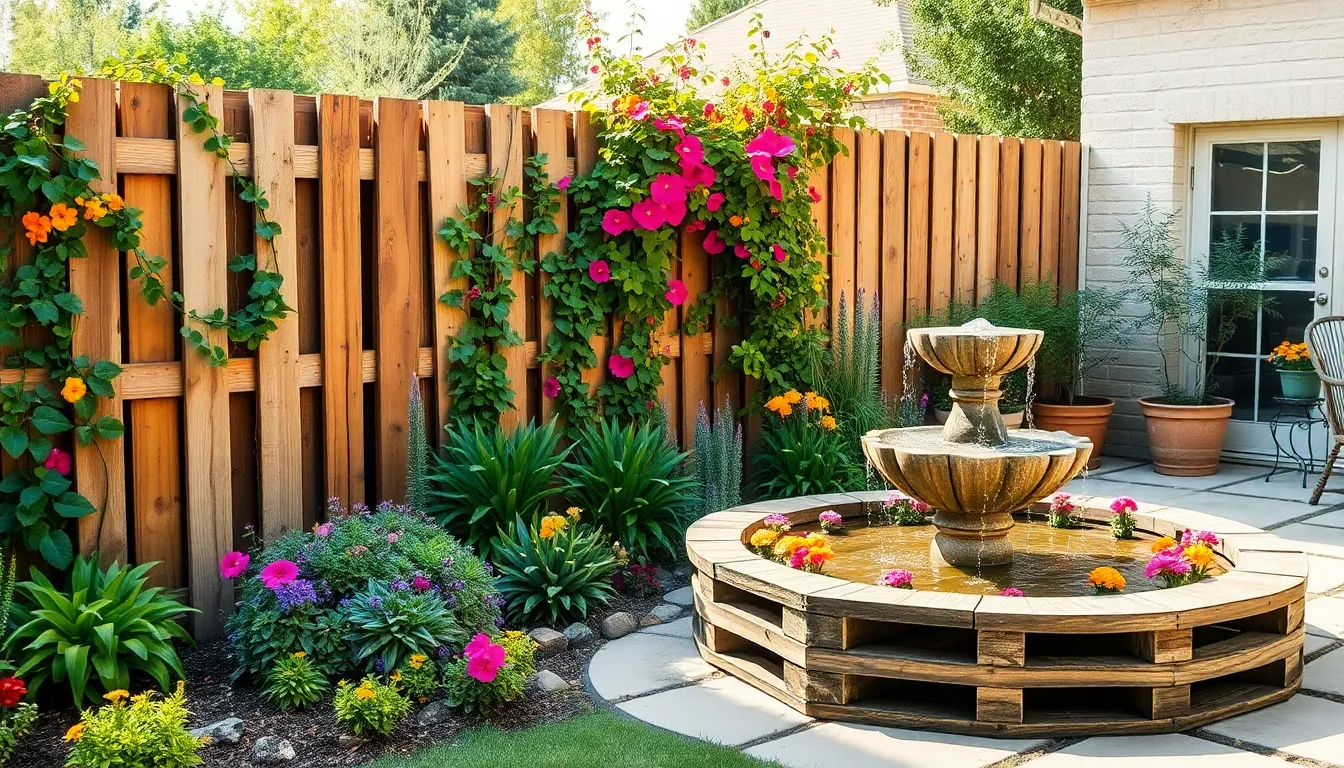
Building decorative garden features from repurposed pallets transforms our outdoor spaces into stunning visual displays. We can create functional structures that add character while maintaining an eco-friendly approach to garden design.
Pallet Fence Panels and Privacy Screens
Pallet fence panels offer an economical way to define garden boundaries while creating secluded patio spaces. We start by sanding down rough edges and applying non-toxic outdoor paint to enhance durability and aesthetic appeal. Connecting multiple pallets creates continuous privacy screens that can reach heights of 6-8 feet when properly secured.
Strategic placement of vertical pallet fences doubles their functionality as both privacy barriers and support structures for climbing plants. We can position these screens to block unwanted views while creating natural green walls that bloom throughout growing seasons. Installing pallets vertically maximizes their structural integrity and provides excellent anchoring points for vines, beans, and flowering climbers.
Rustic fence panels work exceptionally well when painted in earth tones or left natural with clear weatherproofing sealant. We recommend spacing pallets 6-8 inches apart for proper drainage and air circulation while maintaining privacy coverage. Adding decorative elements like string lights or hanging planters transforms basic fence panels into stunning focal points.
Pallet Garden Trellises for Climbing Plants
Pallet garden trellises provide excellent support systems for climbing plants while saving valuable ground space in our gardens. We can mount these structures against walls or create freestanding versions that serve as natural room dividers in larger patio areas. The slatted pallet design creates an ideal framework for plants to grow upwards, reaching heights of 5-6 feet when properly anchored.
Constructing wall-mounted pallet trellises requires securing them to sturdy surfaces using heavy-duty brackets and galvanized screws. We position these supports at least 4 inches from walls to allow proper air circulation behind climbing plants. Freestanding versions need concrete footings or weighted bases to withstand wind loads and plant growth weight.
Popular climbing plants for pallet trellises include morning glories, clematis, and edible varieties like peas and pole beans. We plant these at the base of each vertical slat, allowing 12-18 inches between plantings for optimal growth spacing. Training plants through the pallet openings creates lush green backdrops that bloom with colorful flowers or produce fresh vegetables throughout the season.
Pallet Water Feature and Fountain Projects
Pallet water features combine natural wood charm with soothing water sounds to create unique garden focal points. We use pallets as sturdy framing structures for fountains, incorporating additional waterproofing materials like pond liner and marine-grade sealants. These features work best when positioned on level surfaces with access to electrical outlets for pump systems.
Building pallet fountain bases requires reinforcing the wood structure with waterproof coating and ensuring proper drainage around the feature. We recommend using heat-treated pallets for water projects, as they resist moisture damage better than standard pallets. Adding decorative stones, river rocks, or ceramic tiles enhances the visual appeal while providing textural contrast to the wood elements.
Simple pallet water walls create stunning vertical features that fit perfectly in corner spaces or against existing garden walls. We construct these by mounting pallets vertically and installing cascading water systems that flow down through the slats. Incorporating aquatic plants like water lilies or floating flowers adds natural beauty while helping maintain water quality in our DIY fountain systems.
Construct Outdoor Dining and Entertainment Spaces
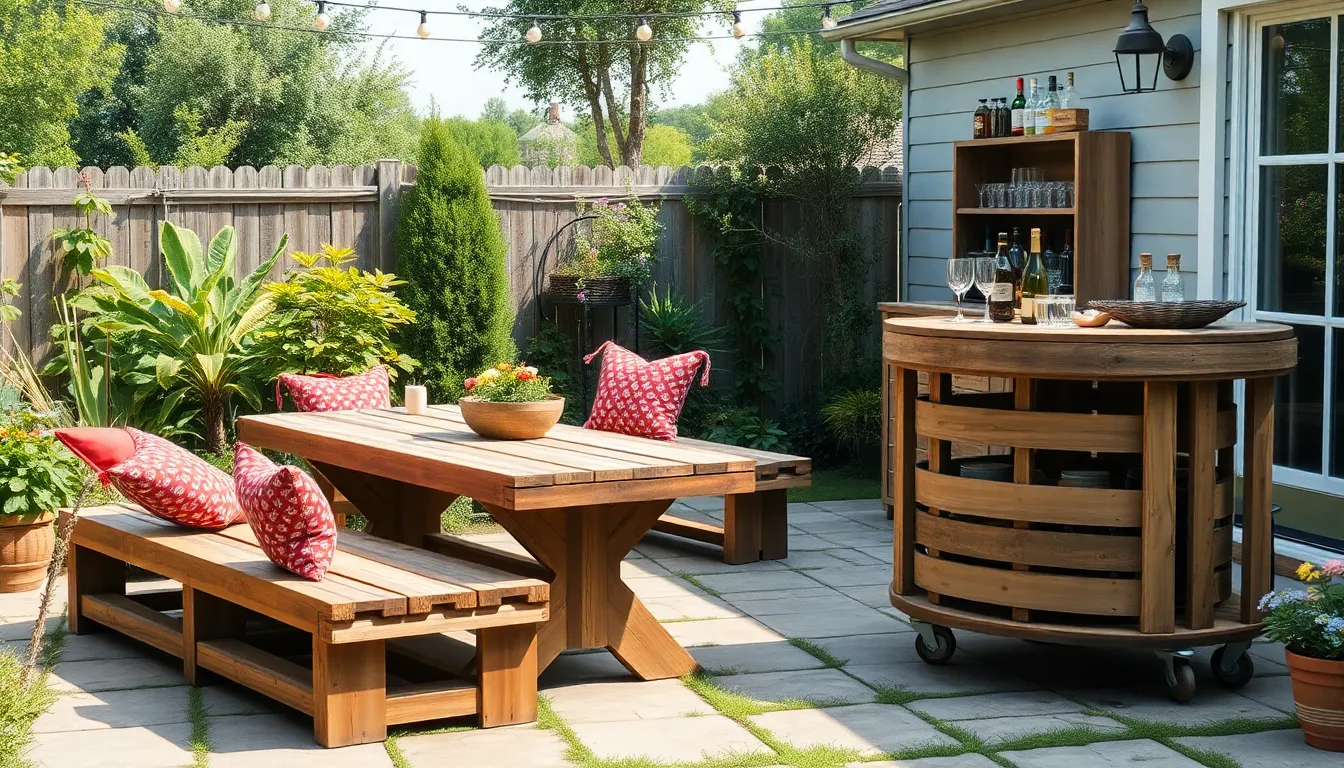
Creating functional entertainment areas transforms our outdoor spaces into inviting social hubs where family and friends can gather comfortably.
Pallet Picnic Tables and Outdoor Dining Sets
Building pallet picnic tables offers an affordable way to create sturdy outdoor dining furniture. We can customize these rustic pieces to fit our exact space requirements and seating needs. Sanding the wood smooth prevents splinters while painting or staining provides weather resistance for year round use.
Designing complete dining sets from pallets creates cohesive outdoor eating areas. Multiple pallets can be combined to construct matching benches that complement our handmade tables. Adding cushions or seat pads enhances comfort during longer meals and gatherings.
Treating pallet wood with weather resistant finishes extends furniture lifespan significantly. Marine grade polyurethane and outdoor wood stains protect against moisture damage and UV rays. Regular maintenance keeps our dining sets looking fresh and prevents wood deterioration.
Pallet Bar Carts and Serving Stations
Constructing mobile bar carts from pallets creates versatile outdoor serving answers. We can incorporate shelves and storage compartments for bottles, glasses, and party accessories. Adding wheels transforms these stations into portable units that move easily around our patio or garden.
Installing convenient features enhances bar cart functionality for entertaining. Stemware racks keep wine glasses secure during transport while built in trays provide stable surfaces for mixing drinks. Towel holders and bottle openers add professional touches to our homemade serving stations.
Following DIY tutorials simplifies the bar cart construction process. Free plans available online provide step by step instructions and customization ideas for different skill levels. We can modify designs to match our exact entertaining needs and available space.
Pallet Fire Pit Surrounds and Seating Areas
Creating fire pit surrounds with pallet wood defines cozy outdoor gathering spaces. These structures provide attractive boundaries around fire features while offering integrated seating options. Arranging pallet benches in circular or square patterns encourages conversation and social interaction.
Sealing pallet wood ensures durability in outdoor fire pit environments. Heat resistant finishes protect against sparks and weather damage while maintaining the rustic aesthetic. Proper treatment allows our fire pit furniture to withstand regular use and seasonal changes.
Positioning pallet seating at safe distances creates comfortable fire pit areas. Strategic placement provides warmth without exposing guests to excessive heat or smoke. Adding back supports and cushions increases comfort for extended evening gatherings around the fire.
Develop Vertical Growing Systems for Maximum Space Efficiency
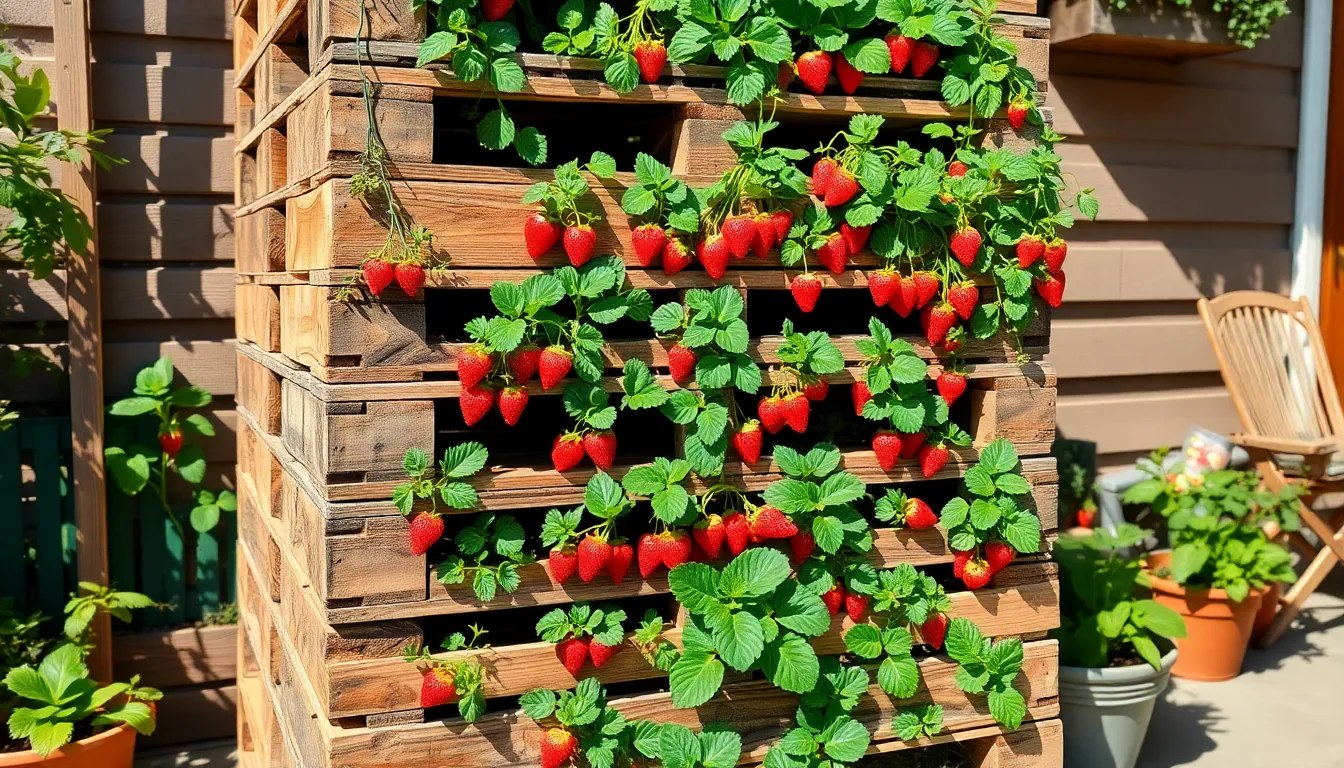
Maximizing our patio and garden space becomes essential when working with limited square footage. Vertical pallet systems let us grow more plants upward rather than outward, transforming unused wall space into productive growing areas.
Pallet Tower Gardens for Strawberries and Herbs
Tower gardens built from stacked pallets create perfect growing conditions for strawberries and herbs. Configuring multiple pallets vertically with strategic gaps provides excellent drainage and airflow circulation that these plants require. We position planting pockets at different levels to accommodate various root depths and growth patterns.
Strawberries thrive in pallet towers because the elevated structure prevents fruit rot and pest issues. The vertical design allows berry runners to cascade naturally while keeping fruit clean and accessible for harvesting. Herbs like basil, oregano, and thyme benefit from the improved air circulation that prevents common fungal problems.
DIY tower designs often include pallet legs or bucket supports at the base for water collection. These systems capture excess water and recycle it back through the tower, creating sustainable irrigation cycles. Water conservation becomes automatic as we eliminate runoff waste while maintaining consistent moisture levels.
Pallet Living Walls with Integrated Irrigation
Living walls constructed from pallets require integrated irrigation systems for optimal plant health. Recirculating irrigation systems work best when direct water lines aren’t available, using water tanks, pumps, timers, and moisture sensors. We create holes in pallet pockets to ensure even water distribution while preventing overwatering damage.
Professional systems like Florafelt offer modular pallet units optimized for vertical planting. These pre-made answers eliminate guesswork in irrigation design while providing consistent growing conditions. The integrated approach ensures every plant receives adequate water without manual intervention.
Water cycling mechanisms can pump water upward without electricity in innovative DIY designs. These systems use gravity and pressure differentials to distribute water evenly across all planting levels. We eliminate the need for power sources while maintaining reliable irrigation throughout the growing season.
Pallet Greenhouse Shelving and Plant Displays
Pallet shelving units inside greenhouses maximize vertical space for potted plant displays. The natural wood structure provides rustic aesthetics while offering sturdy support for plant trays and containers. We can customize shelf heights to accommodate different plant sizes and growth stages.
Multi-tier pallet shelving optimizes sunlight exposure for plants at various heights. Strategic placement ensures shorter plants receive adequate light while taller specimens don’t create excessive shade. Different plant varieties can be grouped based on their exact light and space requirements.
Greenhouse pallet shelving serves dual purposes as both storage and display systems. We organize gardening supplies on lower shelves while showcasing plants on upper tiers. This arrangement keeps essential tools accessible while creating an attractive growing environment that maximizes our greenhouse investment.
Add Lighting and Ambiance Features to Your Pallet Projects
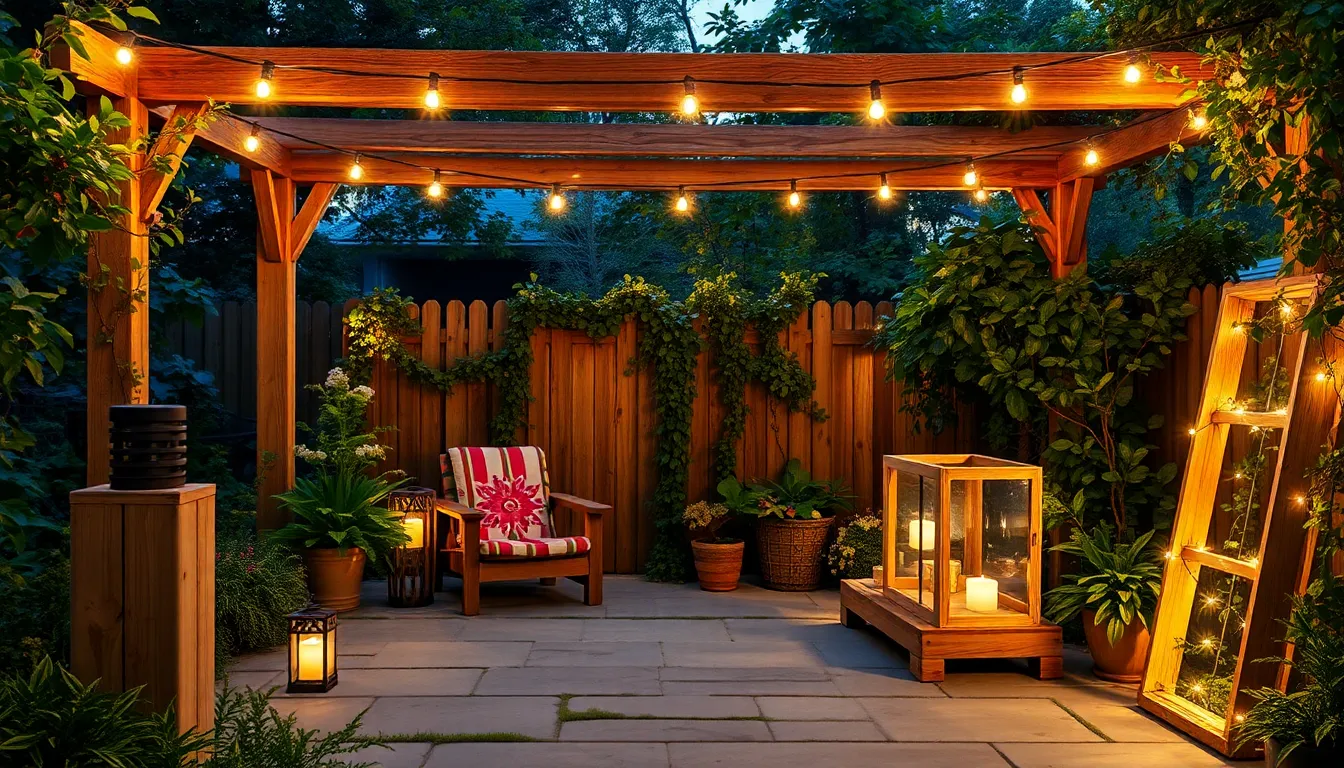
Transform your outdoor spaces into enchanting evening retreats by incorporating lighting elements into your pallet creations. We’ll explore sustainable and creative ways to illuminate your garden and patio areas using reclaimed pallet wood.
Solar Light Integration in Pallet Structures
Solar powered lighting systems offer the perfect eco-friendly solution for your pallet garden projects. We can create solar bollard lamps by repurposing wooden pallets and installing small solar light bulbs that charge during the day and illuminate pathways at night. Basic tools you’ll need include a saw, drill, wood screws, and a hole saw to fit the solar lamp head properly.
Finishing these structures with exterior wood stain or varnish protects the pallets from weather damage while maintaining their rustic appeal. We recommend positioning these solar integrated pallet lights along garden paths or around seating areas for optimal functionality. Battery operated solar bulbs eliminate the need for electrical wiring, making installation simple and cost effective for any skill level.
Pallet Lantern Posts and Garden Lighting
Crafting unique light boxes from pallet wood adds rustic charm and warm ambiance to your outdoor living spaces. We build these lanterns by creating wooden box frames from pallet boards with strategically spaced slats that allow light to shine through in beautiful patterns. Hooks attached inside the box’s top hold string lights securely, with battery operated options eliminating cord management issues.
Strategic placement of these pallet lanterns throughout your garden or patio creates cozy gathering spots perfect for relaxing evenings. We suggest varying the heights and sizes of your lantern posts to create visual interest and depth in your lighting design. Weather resistant materials ensure these handcrafted fixtures withstand seasonal changes while maintaining their aesthetic appeal.
String Light Frames Using Pallet Wood
Building frames from pallet wood provides an elegant display system for string lights in your outdoor spaces. We construct these frames as simple yet effective structures that add soft, warm lighting to patios and garden areas. String lights can be hung directly from pallet wood structures or integrated onto existing pallet planters, fences, or vertical garden setups.
The reclaimed look of pallets enhances the rustic and natural aesthetic that’s ideal for creating inviting outdoor ambiances. We recommend combining pallet wood frames with potted plants and hanging string lights to create charming garden displays that serve both functional and decorative purposes. Modular pallet garden designs paired with integrated LED strips provide nighttime usability for herb gardens and reading nooks, extending the enjoyment of your outdoor spaces well into the evening hours.
Conclusion
We’ve shown you how wooden pallets can completely transform your outdoor space without very costly. From vertical gardens that maximize growing potential to cozy seating areas perfect for relaxation these versatile materials offer endless possibilities for creative homeowners.
The beauty of pallet projects lies in their adaptability to any space size or style preference. Whether you’re looking to create functional storage answers elegant lighting features or entertaining areas there’s a pallet project that’ll work for your unique needs.
We encourage you to start small with one project that excites you most. As you gain confidence and see the incredible results you’ll likely find yourself planning your next pallet transformation. Your dream outdoor oasis is just a few pallets away.
Frequently Asked Questions
What are the main benefits of using wooden pallets for garden projects?
Wooden pallets offer a budget-friendly, sustainable solution for creating garden furniture, planters, and storage. They’re versatile, easy to work with, and help recycle materials that might otherwise go to waste. Pallets can be transformed into vertical gardens, raised beds, seating areas, and decorative features, making them perfect for maximizing small outdoor spaces while adding rustic charm to your garden.
How do I prepare pallets for outdoor garden use?
Start by thoroughly cleaning the pallets and checking for any damage or protruding nails. Sand all surfaces to remove splinters and rough edges. Apply weather-resistant stain or sealant to protect the wood from moisture and UV damage. Ensure pallets are marked “HT” (heat-treated) rather than chemically treated for safety, especially when growing edible plants.
What plants work best in vertical pallet gardens?
Shallow-rooted plants are ideal for vertical pallet gardens, including lettuce, herbs like basil and parsley, strawberries, and small flowering plants. These plants don’t require deep soil and can thrive in the limited space between pallet slats. Avoid deep-rooted vegetables like tomatoes or carrots, which need more soil depth than vertical pallet gardens can provide.
How do I ensure pallet furniture is comfortable and safe?
Sand all surfaces thoroughly to eliminate splinters, then apply a protective finish. Secure any loose boards and reinforce joints with additional screws or brackets. Add weather-resistant cushions for comfort and use outdoor-grade hardware. Regular maintenance, including resealing and tightening connections, will keep your pallet furniture safe and comfortable for years.
Can pallet projects withstand outdoor weather conditions?
Yes, with proper treatment. Use weather-resistant stains, sealants, or paints specifically designed for outdoor use. Choose pallets made from naturally rot-resistant woods when possible. Regular maintenance, including resealing annually and protecting from excessive moisture, will significantly extend the life of your pallet projects. Consider covered storage during harsh weather conditions.
What tools do I need for basic pallet DIY projects?
Essential tools include a hammer, drill with various bits, saw (circular or reciprocating), sandpaper or electric sander, measuring tape, level, and safety equipment like gloves and goggles. For finishing, you’ll need brushes for staining or painting. A pry bar helps disassemble pallets when needed. Most pallet projects require only basic carpentry skills and common household tools.
How much space do I need for pallet garden projects?
Pallet projects are perfect for small spaces. Vertical gardens can fit against walls or fences in areas as small as 4×4 feet. Raised beds can be customized to any size, and many projects like herb gardens or small planters work well on patios, balconies, or even indoors. The vertical nature of many pallet projects maximizes growing space in minimal square footage.
Are there any safety concerns with using pallets for food gardens?
Yes, always verify that pallets are heat-treated (marked “HT”) rather than chemically treated. Avoid pallets that transported chemicals, pesticides, or unknown materials. Clean thoroughly before use and consider lining planters with landscape fabric as an extra barrier. When in doubt, use pallets only for decorative projects or non-edible plants to ensure safety.

